Hero Xpulse 210 Review: Is It Worth the Upgrade? A Detailed First Ride Breakdown
The Hero Xpulse 210 has arrived, promising to elevate the legacy of its predecessor, the Xpulse 200, with enhanced performance, refined ergonomics, and upgraded features—all while staying true to its roots as an accessible, affordable dual-sport motorcycle. Priced at a premium of ₹23,000-₹33,000 over the Xpulse 200 4V, this bike aims to blend highway cruising prowess with off-road capability, drawing inspiration from Dakar Rally riders. As a seasoned motorcycle reviewer with over a decade of riding experience across India’s diverse terrains, I’ve taken the Xpulse 210 for a first ride in the scenic City of Lakes to answer the big question: Is it worth the upgrade?



Introduction: The Evolution of an Affordable Adventure Icon
The Hero Xpulse lineup has long been a favorite among Indian riders seeking a versatile, budget-friendly motorcycle that can tackle both urban streets and rugged trails. With the Xpulse 210, Hero MotoCorp steps up its game, introducing a redesigned frame, a punchier engine, and a host of upgrades to refine the dual-sport experience. Priced at ₹1.48 lakh (ex-showroom) for the base variant and ₹1.58 lakh for the top-spec model, it competes with the likes of the Royal Enfield Himalayan 450 and KTM 250 Adventure—but at a fraction of the cost. But does this evolution justify the price bump over the Xpulse 200? After a hands-on ride, I’ll explain its strengths, weaknesses, and whether it’s the right upgrade for you. Let’s hit the road—and the trails—to find out.
Design and Build: Evolutionary Style with Practical Touches
Aesthetic Evolution
The Xpulse 210 isn’t a radical departure from the 200—it’s an evolution. Hero retains the familiar silhouette but refines it with sharper lines and a more purposeful stance. The front features a round LED headlamp with a protective bar (doubling as a recovery point), while the high-mounted exhaust is slimmer and sleeker than before. The 11-liter fuel tank is subtly reshaped, slimming down near the seat for better stand-up ergonomics. Build quality has noticeably improved, with tighter fit-and-finish compared to the 200, though it’s still not at KTM’s premium level. Available in vibrant colors like matte green and black, it strikes a balance between dual-sport ruggedness and adventure-ready appeal.
Practical Upgrades
Hero has sprinkled practical touches throughout. The rear rack is larger and sturdier—perfect for luggage or as a recovery point after a spill. A new metal bash plate replaces the 200’s flimsier version, offering better engine protection during off-road antics. The 4.2-inch TFT display (on the top variant) adds a modern flair with Bluetooth connectivity, navigation, and phone controls, though its matte finish struggles under direct sunlight. The switchgear feels tactile and premium, elevating the overall experience. At 159 kg (kerb), it’s 10 kg heavier than the 200, yet it feels surprisingly agile—a testament to smart engineering.
Verdict: The design evolves thoughtfully, blending style with utility. It’s not a showstopper like the KTM 390 Adventure, but it’s a practical, rugged looker.
Ergonomics: Comfort Meets Command
Rider-Focused Adjustments
Swing a leg over the Xpulse 210, and it feels familiar yet refined. The seat height rises slightly to 830 mm (from 825 mm), but the slimmer tank front makes it easier for shorter riders to plant their feet—I’m 5’6” and had no issues. The bolt-on offset handlebar offers adjustable reach, with optional risers (5-20 mm) for taller riders. Footpegs are height-adjustable, and the brake pedal can be tweaked for boot-friendly riding. These tweaks shine when standing, offering a commanding posture that outclasses the Xpulse 200 and even rivals the KTM 390 Adventure in comfort.
Seat and Pillion Comfort
The new seat is a highlight—better cushioned for both rider and pillion, with a narrower front for easier ground reach. It’s a boon for long rides, though the pillion perch remains compact, better suited for short trips. The soft suspension (more on that later) complements the seat, soaking up bumps for a fatigue-free experience on highways or trails.
Verdict: Ergonomics are a big win—versatile, adjustable, and comfy for solo riders, though pillion space is still a compromise.
Engine and Performance: More Power, Better Delivery
The Heart of the 210
Borrowed from the Karizma XMR, the Xpulse 210’s 210cc, liquid-cooled, single-cylinder engine pumps out 24.6 bhp at 9,250 RPM and 20.7 Nm at 7,250 RPM—up 5 bhp and 3 Nm from the Xpulse 200. Hero tweaked the cams and bumped the rear sprocket to 46 teeth (up from 42), boosting low-end tractability. On inclines where the 200 demanded first or second gear, the 210 cruises effortlessly in third or fourth, making technical off-road sections a breeze. The six-speed gearbox is slick, with a light clutch pull that’s beginner-friendly.
On-Road and Off-Road Dynamics
Highway cruising is where the 210 shines brightest. It settles happily between 80-100 km/h, with reduced vibes compared to the 200 (though some buzz creeps in above 6,500 RPM). Triple-digit overtakes require patience—the power peaks up top—but twisty roads are a blast when you rev it out. Off-road, the extra grunt and improved suspension make it more playful and confident than its predecessor. One hiccup: my test unit hit limp mode (capped at 6,500 RPM) due to coolant overheating, though no warning appeared—a glitch Hero says was unit-specific.
Verdict: The engine transforms the Xpulse into a more versatile machine—effortless off-road, capable on highways, but not a speed demon.
Suspension and Handling: A Balanced Setup
Upgraded Suspension
The Xpulse 210’s suspension is a major upgrade. The front forks grow from 37 mm to 41 mm, offering increased stiffness and 200 mm of travel (up from 190 mm). The rear features a progressive linked mono shock with 194 mm travel, stiffening nicely over big hits while staying plush over small bumps. Compared to the 200, it squats and dives less under hard braking or acceleration, boosting control.
New Frame, Better Dynamics
A new double-cradle frame replaces the 200’s backbone design, improving stress distribution and protecting the engine during jumps. The wheelbase stretches 35 mm (to 1,426 mm), and overall length grows by 40 mm, enhancing stability. A 1% shift in front weight distribution sharpens handling. Despite the 10 kg weight gain, the 210 feels lighter and more agile—second only to the Royal Enfield Himalayan among Indian bikes in my book.
Verdict: Suspension and handling strike a sweet spot—stable on roads, nimble off them, and forgiving for all skill levels.
Braking and Tires: Reliable but Room to Grow
Braking Performance
The Xpulse 210 retains the 200’s 276 mm front disc and 220 mm rear disc, but braking feels sharper thanks to reduced dive and grippier Eurogrip tires (90/100-21 front, 120/80-18 rear). Dual-channel ABS offers three modes—Road, Trail, and Off-Road—letting you toggle rear ABS off on the fly. It’s progressive and confidence-inspiring, though not as biting as the KTM’s sintered-pad setup.
Tire Trade-Offs
The block-pattern Eurogrips are a step up from the 200’s tires, offering decent grip on mixed surfaces. However, they’re not as aggressive as premium off-road rubber, limiting extreme trail performance. For serious off-roading, an upgrade might be worth considering.
Verdict: Braking and tires are solid for the price, but enthusiasts may want more bite and grip.
Features and Tech: Modern Meets Practical
TFT Display and More
The top-spec Xpulse 210’s 4.2-inch TFT display is a standout—bright, colorful, and packed with Bluetooth, navigation, and gear position readouts. Sunlight legibility is a weak point, but it’s a leap over the 200’s LCD. The base model sticks with a simpler screen, keeping costs down. Knuckle guards, a tall windscreen, and a USB charger (optional on base) add practicality.
ABS Modes and Recovery Points
Three ABS modes cater to varied terrains, while the headlamp bar and rear rack double as recovery points—a thoughtful nod to off-roaders. It’s not loaded with tech like the KTM 390 Adventure, but it covers the essentials well.
Verdict: Features enhance usability without overwhelming—smartly curated for the price.
Pricing and Value: Worth the Premium?
The base Xpulse 210 costs ₹1.48 lakh (ex-showroom), ₹23,000 more than the Xpulse 200 4V. For ₹1.58 lakh, the top variant adds dual-channel ABS, TFT, windscreen, and knuckle guards—a ₹33,000 jump from the 200’s base. Compared to the Himalayan 450 (₹2.85 lakh+) or KTM 250 Adventure (₹2.5 lakh+), it’s a steal. The catch? Hero’s Premier dealership network (65 outlets vs. thousands of regular ones) limits accessibility, though expansion is underway.
Verdict: The upgrade is worth it for the performance and features, especially at this price point.
Drawbacks to Consider
- Limited Dealerships: Only 65 Premier outlets sell it—check availability near you.
- Pillion Space: Compact rear seat isn’t ideal for long two-up rides.
- Tire Grip: Eurogrips are decent but not top-tier for hardcore off-roading.
- Minor Glitches: Limp mode on my unit hints at potential teething issues.
Final Verdict: Should You Upgrade to the Xpulse 210?
The Hero Xpulse 210 is a significant leap over the 200, refining ergonomics, boosting power, and enhancing handling—all while keeping affordability and simplicity at its core. It’s not the most extreme off-roader (a Rally variant is coming), but it’s a versatile, beginner-friendly dual-sport that excels on highways and trails alike. For Xpulse 200 owners, the upgrade justifies the ₹23,000-₹33,000 premium with tangible improvements. New buyers seeking a budget adventure bike won’t find much better under ₹1.6 lakh. It’s not perfect, but it’s damn compelling.
Yes, with better power, suspension, and ergonomics, the ₹23,000-₹33,000 premium is justified for most riders.
Great for light trails with improved suspension and power, but tires limit extreme off-road performance.
Expect 35-40 km/l (estimated), slightly less than the 200 due to the bigger engine—real tests pending
Author Bio
Autocar India – Motorcycle Expert & Content Specialist
I’m Auto car India, a passionate rider with 10+ years of experience reviewing bikes. From off-road adventures to urban commutes, I deliver honest, detailed insights.

